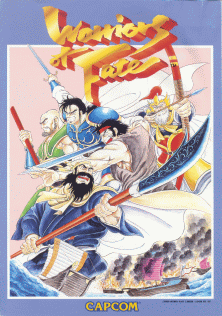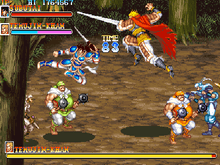Warriors of Fate
| Warriors of Fate | |
|---|---|
 | |
| Developer(s) | Capcom |
| Publisher(s) | Capcom |
| Platform(s) | Arcade, PlayStation, Sega Saturn, FOMA i-αppli, Capcom Power System Changer |
| Release date(s) | Arcade: November 1992 PlayStation: March 22, 1996 Sega Saturn: September 6, 1996 FOMA i-αppli: March 1, 2005 |
| Genre(s) | Beat 'em up |
| Mode(s) | Up to 3 players simultaneously |
| Cabinet | Upright |
| Arcade system | CPS-1 + QSound |
| Display | Raster, 384 x 224 pixels (Horizontal), 4096 colors |
Warriors of Fate, known in Japan as Tenchi o Kurau 2: Sekiheki no Tatakai (Japanese: 天地を喰らう2 赤壁の戦い Hepburn: lit. "The Devouring of Heaven and Earth II: Battle of Red Cliffs"), is a side-scrolling beat-'em-up produced by Capcom first released as a coin-operated arcade game in 1992. It is the second arcade game based on the Tenchi wo Kurau manga, following Dynasty Wars.
Gameplay
Warriors of Fate is a beat'em up with 9 stages, in each of which there are large mobs including spearman, archers, strongmen, bomb-wielding opponents, and at least one Wei boss. There can be up to three players on-screen at the same time. Using two buttons, Attack and Jump, the characters all have standard moves typical of Capcom side-scrollers of the day. Common enemies including Wei soldiers such as bandits, privatees, wrestlers, fatties and thieves will keep popping up from everywhere. In the end of each stage there is a Wei general as stage boss. Li Dian, Xiahou Dun, Xu Chu, Zhang Liao, Cao Ren, Xu Huang, the infamous Lu Bu as final boss. After defeating them all, there is also Cao Cao himself who would try to escape.
There is also a variety of weapons in the game which can be picked up. As with most side-scrollers, food is used to replenish health and can be found in various breakable containers in the game level. One notable feature of the game is the ability to summon a warhorse which adds more attacks to the characters, generally involving pole-arms (except long bow for Huang Zhong). Each character except Zhao Yun was given a special wrestling throw of their own, like in Final Fight and The Punisher.
Even in the US release, the game was particularly gory for its time. Slash weapons and special moves would have an additional maiming effect on enemies when used for the final blow and the enemy boss can be blown up, decapitated, or had their bodies severed. Notably, even while using bare fists, certain characters could still cleave enemies in half, exposing vital organs, and leaving a terrible mess nobody wants to clean up. This tactic even works on some bosses and coincidentally ends up showing more gory detail since the bosses are larger characters.
The game included two bonus stages in the middle wherein the characters compete in an feast which required rapid pressing of buttons and rotations of the joystick and another is where the characters practice their skills on the practice dummies of the final boss. If there are multiple players, the second bonus stage will have the players spar with each other for the glory of the emperor, gaining massive bonus points and bragging rights in the arcade. After wards, both characters continue as if nothing had occurred.
Story
Japanese version
Tenchi wo Kurau II follows Liu Bei's plight in Jingzhou from Romance of the Three Kingdoms, a history-based novel of China, set in the Three Kingdoms period as Cao Cao sets to invade his lands. In Warriors of Fate, Shu Han, led by Liu Bei, as in the novel, was everything "good" and "righteous", while Wei, led by the ever suspicious and cunning Cao Cao, is portrayed as "evil" and "bad". Liu Bei's warriors begin by fighting Cao Cao's forces at the Battle of Bowang, then Battle of Changban, then finally join up with Sun Quan to fight at the Battle of Red Cliff. If the Five Tigers slays Cao Cao, Wu and Shu join forces and unites Wei and returns the Han back to rule and restore peace, if not Cao Cao escape and history continues as intended with the land in turmoil and the eventual demise of Shu.
English version
In the English adaptation, however, the Three Kingdoms theme was lost, and most names have been changed to names of Mongolian origin. The story takes place in a fictional realm where the evil overlord Akkila-Orkhan (originally Cao Cao) of Shang-Lo tries to conquer his neighbouring countries, converting them into ruin and despair. Kuan-Ti (originally Liu Bei), with the aid of the five great warriors, stands up against the conquering shadow and fights to defend his people and lands.
Playable characters
Unlike the first game, Dynasty Wars, Liu Bei is not playable. The playable characters were Zhang Fei, Guan Yu, Zhao Yun, Huang Zhong, four of the famous Five Tiger Generals, and Wei Yan. Although in the novel Huang Zhong and Wei Yan had not joined Liu Bei before the Battle of Red Cliffs, they are available as playable characters in this game because of pleadings from fans of the Three Kingdoms
| Character | Name in game (Japanese ver.) | Name in game (English ver.) | Weapon (Melee) | Weapon (Mounted) | Special Abilities | Dash Attack | Special Throw |
|---|---|---|---|---|---|---|---|
| Guan Yu | 関羽 (Kan-U) | Portor | bare hand | guan dao | flying elbow | head butt | jumping backbreaker |
| Average and balanced in speed and power | |||||||
| Zhang Fei | 張飛 (Chō-Hi) | Kassar | bare hand | viper halberd | crushing punch | sliding shoulder strike | - jumping vertical suplex - pile driver |
| High damage, low speed, | |||||||
| Zhao Yun | 趙雲 (Chō-Un) | Subutai | sword | spear | uppercuting slash | rushing shoulder strike | none |
| Agile, long reach, low damage. Cannot do piledriver (will kick foe in the face instead). Can do air grab | |||||||
| Huang Zhong | 黄忠 (Kō-Chū) | Kadan | bow, dagger | bow, halberd | triple shot, uppercuting slash | somersault | over the shoulder powerbomb |
| Ranged attacks, vulnerable in melee. | |||||||
| Wei Yan | 魏延 (Gi-En) | Abaka | katana | katana | flash kick | sliding elbow | helicopter power slam |
| Combos, shorter reach | |||||||
Stage bosses
| Stage | Stage name | Bosses (Japanese ver.) | Bosses (English ver.) |
| 1st | Battle on Hakubō Slope-Part 1(Battle of Bowang) 博望坡の戦い 一 |
Ri-Ten (Li Dian) 李典 | Gaidu |
| 2nd | Battle on Hakubō Slope-Part 2 (Battle of Bowang 2) 博望坡の戦い 二 |
Kakō-Ton (Xiahou Dun) 夏侯惇 | Lhaze |
| 3rd | New Field Region (Xinye) 新野城 |
Kyo-Cho (Xu Chu) 許褚 | Taranis |
| Mei-Mei, Mei-Ya, Mei-Ling 美美, 美冴, 美鈴 | Izia, Arika, San-Jin | ||
| 4th | White River 白河 |
Sō-Jin (Cao Ren) 曹仁 | Atika |
| 5th | Battle on Chōhan Slope (Battle of Changban) 長坂坡の戦い |
Jun'u-Dō (Chunyu Dao) 淳于導 | Baidu |
| 6th | Chōhan Bridge (Changban Bridge) 長坂橋 |
An-Mei (Yan Ming), Kakō-Ketsu (Xiahou Jie) 晏明, 夏侯傑 | Jerreck, Dasadas |
| 7th | Battle of Redwall-Part One (Battle of Red Cliff) 赤壁の戦い 一 |
Chō-Ryō (Zhang Liao) 張遼 | Kublai-Dakan |
| 8th | Battle of Redwall-Part Two (Battle of Red Cliff 2) 赤壁の戦い 二 |
Jo-Kō (Xu Huang) 徐晃 | Kai'Bataar |
| 9th | Kayō Path (Huarong Trail) 華容道 |
Ryo-Fu (Lü Bu) 呂布 | Temujin-Khan |
| Sō-Sō (Cao Cao) 曹操 | Akkila-Orkhan |
Continuation screen
Like Final Fight and the arcade version of Ninja Gaiden, Warriors of Fate featured a notorious continuation screen. Once the player loses all lives, the screen changes to a graphically violent image of the character on his knees unable to get back up while two Wei soldiers move in for the kill. If the player does not insert a coin and/or press START within the 20 second countdown, it is implied they will kill the character (and the game will be over).
Other information
- The US version omitted a cutscene (Stage 6, the historical battle of Changban) which involved Liu Bei's wife turning her son Liu Shan to the player (in the novel she actually turned him to Zhao Yun), then throwing herself down a well.
- In homage to Capcom's earlier 1991 hit Street Fighter, several character moves seem very similar to special moves in Street Fighter II. Subutai's special move is an uppercut slash that resembles Ryu's "Shoryuken", Abaka's special resembles Guile's "Flash Kick", Lhaze's special resembles Dhalsim's "Yoga Flame", Taranis' special resembles Blanka's "Rolling Attack" and Zhang Fei's throw resembles Zangief's "Screw Piledriver".
- There is a special ending credits sequence (if completed with one credit) with two figures dressed up and fighting like Ryu and Ken from the Street Fighter series while a comical rendition of Ken's theme is playing.
- There are 3 special chests in the game, containing 3 legendary weapons:
- In Stage 7, a secret chest before entering the boss' room, you will find secret weapon ""Excalibur"". Go to the left of the stage, and do jumping punch. A secret chest will surely drop.
- In Stage 8, a secret chest in the boss room can be either empty or bring out the Hiryu, (lit. Flying Dragon) a Japanese katana. It may be a reference to the protagonist of Capcom's hit video game Strider, Strider Hiryu.
- In Stage 9, a secret chest midway of the stage contains the Kusanagi (Ame no Murakumo), a blue flaming sword and the game's most powerful weapon.
- Special weapons - There are 3 enemies who carry special weaponry. Two carry unique swords, and one carries, an iron hammer a unique mace:
- In Stage 6, a man on horseback named Xiahou En (Sugisugi in US version) appears on screen briefly. Killing him on screen earns the sword Qin Gong (Seikou in US version). This is a reference to the plot described in Romance of the Three Kingdoms, where Xiahou En was killed by Zhao Yun, and the latter got the sword.
- In the end of the same stage, there is a black wrestler with the 6th boss. However, he can either drop the rainbow Shichisei (Seven Star Sword) or a barbecue.
- In Stage 8, there is a huge hall with a huge mob of wrestlers. Kill the dark-skinned wrestler and he will randomly drop the Kai club, a decorated mace.
- At the 7 stage appears an iron hammer, this hammer trip the opponent, hitting him repeatedly and allowing every shot is just watches ducks or stars by the blow and this is fun (also tidal bosses).
| ||||||||||
.png)
